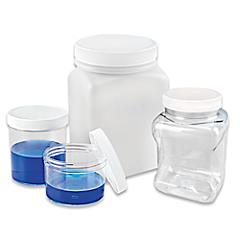The Scepter-style blow-molded fuel and water containers are nearly indestructible, and are used throughout the world by the US military.
I've been carrying one or more of the 5 gallon water containers for the last few years, but always wanted some easy way to dispense water without needing to siphon it out or tip the container. With a weight of over 42 lbs, manipulating a filled container in the back of an FJ is inconvenient, especially when fully loaded with camping gear, etc.
There are several different options for little submersible electric pumps, or pressurizing the tank with a bicycle pump or compressor, but all of them have design weaknesses that I didn't want to deal with.
I wanted a non-electric solution that didn't require batteries or any wires draped across the cargo area, and would allow the container to be removed from the vehicle and still have the dispensing function.
The air-pressurized scheme was a no-go because a special wrench is required to get the lid to seal tightly enough to retain pressure. More importantly, the container would need to be re-pressurized multiple times as water was withdrawn.
There are some online writeups about adapting a NZ-made Fynspray manual pump, but at over $125 the pump is quite expensive, and because the flat base is designed to be mounted on a countertop, it doesn't really fit correctly on the radiused face of the Scepter cap.
Because of these problems, I wanted to go with a simple, reliable, high-quality hand-operated mechanical pump that would work inside the vehicle as well as out. No wires, no need to constantly re-pressurize the container, just a reliable hand pump, and no parts sourced from the "C" country.
I ended up using an Irish-made Whale Mk-6 hand pump, (~ $60), something that's been used for 30 years in marine applications. The pump is secured in the water jug's lid using a collet-type, water-tight nylon electrical cable feed-through. A segment of 1/2" diameter medical grade silicone tubing extends the pump inlet to the bottom of the container.
Not cheap, but functional and reliable, and should last as long as the FJ does. The pump can be rotated in the feed-through to position the spout over the top of the container for protection.
![Image]()
![Image]()
![Image]()
![Image]()
![Image]()
I've been carrying one or more of the 5 gallon water containers for the last few years, but always wanted some easy way to dispense water without needing to siphon it out or tip the container. With a weight of over 42 lbs, manipulating a filled container in the back of an FJ is inconvenient, especially when fully loaded with camping gear, etc.
There are several different options for little submersible electric pumps, or pressurizing the tank with a bicycle pump or compressor, but all of them have design weaknesses that I didn't want to deal with.
I wanted a non-electric solution that didn't require batteries or any wires draped across the cargo area, and would allow the container to be removed from the vehicle and still have the dispensing function.
The air-pressurized scheme was a no-go because a special wrench is required to get the lid to seal tightly enough to retain pressure. More importantly, the container would need to be re-pressurized multiple times as water was withdrawn.
There are some online writeups about adapting a NZ-made Fynspray manual pump, but at over $125 the pump is quite expensive, and because the flat base is designed to be mounted on a countertop, it doesn't really fit correctly on the radiused face of the Scepter cap.
Because of these problems, I wanted to go with a simple, reliable, high-quality hand-operated mechanical pump that would work inside the vehicle as well as out. No wires, no need to constantly re-pressurize the container, just a reliable hand pump, and no parts sourced from the "C" country.
I ended up using an Irish-made Whale Mk-6 hand pump, (~ $60), something that's been used for 30 years in marine applications. The pump is secured in the water jug's lid using a collet-type, water-tight nylon electrical cable feed-through. A segment of 1/2" diameter medical grade silicone tubing extends the pump inlet to the bottom of the container.
Not cheap, but functional and reliable, and should last as long as the FJ does. The pump can be rotated in the feed-through to position the spout over the top of the container for protection.








